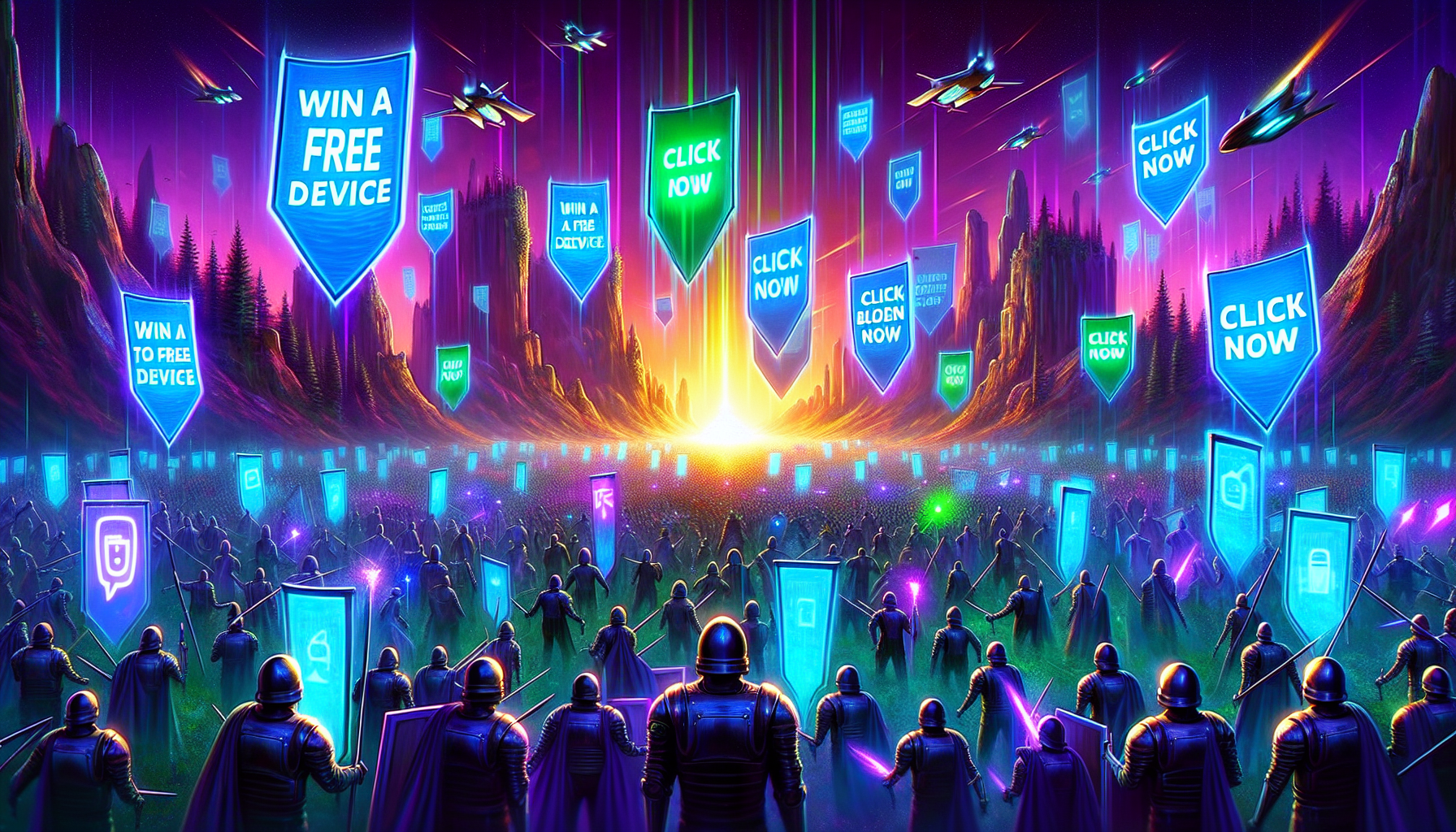Ethan Zuckerman developed the first pop-up ad in the late 1990s during his time at Tripod.com, crafting it as a straightforward JavaScript solution to keep advertisers separate from inappropriate user-generated content. In 2014, Zuckerman publicly apologized for his creation, recognizing that his well-intentioned technical fix transformed into one of the internet’s most hated advertising formats that severely harmed online user experience and trust.
Key Takeaways
- Ethan Zuckerman invented pop-up ads at Tripod.com in the late 1990s using JavaScript to separate advertisements from potentially controversial user content, but his solution created far more problems than it solved.
- In 2014, Zuckerman issued a public apology stating “I wrote the code to launch the window and run an ad in it. I’m sorry,” acknowledging the negative impact his creation had on internet users worldwide.
- Pop-up ads quickly evolved from a respectful advertising solution into aggressive marketing tactics that destroyed user trust, causing banner ad click-through rates to plummet from 44% to below 1%.
- Users fought back against intrusive pop-ups by adopting ad blockers and demanding browser-level blocking features, forcing the advertising industry to develop less disruptive alternatives.
- Modern pop-up variations still exist today but focus on user experience through strategic timing, exit-intent technology, and value-driven content like newsletter signups and security alerts rather than aggressive interruption.
Further Reading
If you’re interested in Zuckerman’s full reflection on the invention and consequences of pop-up ads, you can read his essay published in The Atlantic.
The Code That Launched a Thousand Annoyances: Zuckerman’s JavaScript Creation
Ethan Zuckerman created the first-ever pop-up ad while working at Tripod.com in the late 1990s, unknowingly launching one of the internet’s most universally despised advertising formats. His simple JavaScript solution would eventually become the source of countless frustrated clicks and the inspiration for entire industries built around blocking unwanted content.
The Original Problem and Solution
The web-hosting service Tripod.com faced a delicate situation when an advertiser complained about their banner appearing on a user page containing adult material. Traditional banner ads placed directly on web pages created unwanted associations between advertisers and content they couldn’t control. Zuckerman’s ingenious workaround involved using JavaScript to open a modal window that displayed advertisements completely separate from the website’s content.
This technical approach solved the immediate problem by creating a clear distinction between user-generated content and advertising. The pop-up window operated independently, ensuring that advertisers wouldn’t be associated with potentially offensive or inappropriate material on personal websites. However, this solution came with an unintended consequence that would plague internet users for decades.
The JavaScript Mechanics Behind the Madness
The earliest pop-up ads relied on straightforward JavaScript commands that opened new browser windows automatically when users visited specific pages. These scripts triggered without user consent, creating additional browser windows that demanded attention and action to close. The simplicity of the code made it easy to implement across different websites, contributing to its rapid adoption throughout the internet.
Website operators quickly recognized the potential of this technology to capture user attention more aggressively than traditional banner advertisements. Pop-ups couldn’t be ignored like banner ads, which users had already begun to treat as visual noise. The forced interaction required to close these windows guaranteed that users would at least acknowledge the advertising message, even if their response was overwhelmingly negative.
The creator of this advertising format later expressed profound regret about his invention’s impact on user experience. Zuckerman’s apology acknowledged that his technical solution created far more problems than it solved, fundamentally changing how people interact with online content.
Marketing teams across various industries embraced pop-up technology with enthusiasm, often implementing multiple overlapping windows that created increasingly frustrating user experiences. The technique’s effectiveness at capturing attention made it irresistible to advertisers, despite growing user complaints and the development of browser-based blocking tools.
Browser developers eventually responded to widespread user frustration by implementing built-in pop-up blockers, but the damage to online advertising’s reputation had already been done. The inventor’s subsequent regret highlighted the disconnect between technical innovation and user experience considerations that characterized early internet development.
Modern web advertising continues to grapple with the legacy of Zuckerman’s creation, as users remain skeptical of intrusive advertising formats. The pop-up ad’s evolution into various forms of overlay advertising, modal dialogs, and interstitial content demonstrates how the core concept persists despite widespread opposition.
The JavaScript technique that powered the first pop-up ads represented a turning point in online advertising, establishing a precedent for prioritizing advertiser needs over user experience. This approach would influence digital marketing strategies for years to come, creating an adversarial relationship between content creators and their audiences that continues to shape internet culture today.

“I’m Sorry” – The Creator’s 2014 Apology
The Public Confession
In 2014, Ethan Zuckerman made a statement that surprised the digital world. The man responsible for creating pop-up advertisements published an essay that began with a simple but powerful admission: “I wrote the code to launch the window and run an ad in it. I’m sorry. Our intentions were good.” This unexpected apology came decades after his initial creation had become one of the internet’s most despised features.
Zuckerman’s confession resonated with millions of internet users who had spent years battling unwanted windows that disrupted their browsing experience. His straightforward acknowledgment of responsibility marked a rare moment when a technology creator openly addressed the unintended consequences of their innovation. The creator of pop-up ads didn’t hide behind corporate speak or deflect blame to others.
Understanding the Original Vision
The apology revealed the genuine motivations behind the pop-up ad’s creation. Zuckerman and his team at Tripod had developed what they believed was an elegant solution to multiple problems facing the early internet. Their system allowed brands to protect their reputation by preventing their advertisements from appearing next to potentially controversial content. Websites could continue offering free services to users while generating necessary revenue. Users retained the ability to close unwanted advertisements with a simple click.
This original vision painted a picture of mutual benefit across all stakeholders. However, the reality proved far different from these initial intentions. The man who invented internet advertising concepts watched as his creation evolved into something far more intrusive and problematic than anyone had anticipated.
Zuckerman’s essay sparked broader discussions about technology ethics and the responsibility developers bear for their creations’ long-term impact. His apology highlighted how advertising-driven internet models can create unintended consequences for user privacy and experience. The confession also raised important questions about whether good intentions justify potentially harmful innovations, even when those consequences weren’t foreseeable at the time of creation.
The timing of his apology coincided with growing concerns about digital privacy and user experience across the internet. Many viewed his statement as a catalyst for examining how technology companies prioritize revenue generation over user satisfaction and privacy protection.
When Good Intentions Went Horribly Wrong
Pop-up ads transformed from a simple solution into the internet’s most despised advertising format within just a few years. What began as an innocent attempt to keep users on websites while still showing advertisements quickly spiraled into an aggressive marketing free-for-all that damaged the entire online experience.
Marketers discovered they could exploit the pop-up format to force attention and drive conversions, abandoning any consideration for user experience. These tactics became increasingly aggressive throughout the early 2000s, with advertisers treating every website visit as an opportunity to bombard users with unwanted messages. The original vision of respectful, non-intrusive advertising disappeared as companies prioritized immediate results over long-term user satisfaction.
The Decline of Click-Through Rates and User Trust
The effectiveness of online advertising plummeted as pop-ups proliferated across the web. Early banner advertisements, such as AT&T’s pioneering campaign on Hotwired, once achieved remarkable click-through rates of up to 44%. However, as users became overwhelmed by intrusive pop-up formats, these numbers crashed dramatically to below 1%. This decline reflected more than just banner blindness – it represented a fundamental breakdown in the relationship between advertisers and internet users.
Pop-ups ruined user experience through several destructive practices:
- Overlays that blocked content and refused to close properly
- Fake virus alerts designed to panic users into clicking malicious links
- Deceptive download prompts that installed unwanted software
- Multiple windows that opened simultaneously, overwhelming browsers
- Audio advertisements that played without permission
The creator of pop-up ads watched his invention become synonymous with spam, scams, and general internet annoyance. What started as a technical solution to preserve website engagement evolved into a weapon that marketers used to assault users with unwanted content.
The association between pop-ups and malicious practices became so strong that legitimate businesses found their advertisements grouped with obvious scams. Users developed an instinctive distrust of any pop-up window, regardless of the advertiser’s reputation or the product’s quality. This created a hostile environment where even well-intentioned companies struggled to reach their audiences effectively.
The man who invented internet advertising eventually recognized that his creation had veered far from its intended purpose. The technology designed to balance user experience with advertising revenue instead became a source of frustration that drove people away from websites entirely. Pop-ups trained an entire generation of internet users to immediately close or block any unexpected window, making legitimate advertising communications nearly impossible.
The Great Pop-Up War: Users Fight Back
I witnessed firsthand how the internet community mobilized against the pop-up invasion that plagued browsing experiences throughout the early 2000s. The widespread annoyance caused by these intrusive advertisements sparked a digital revolution that fundamentally changed how users interact with online content.
The Rise of Digital Defense Tools
Ad blockers emerged as the primary weapon in users’ arsenal against unwanted pop-ups. Software like AdBlock Plus and uBlock Origin gained millions of downloads as frustrated internet users sought to reclaim control over their browsing experience. These tools didn’t just block pop-ups; they filtered out banner ads, video advertisements, and other disruptive content that interrupted normal web usage.
The adoption rate of ad blocking software skyrocketed as people shared recommendations across forums and social media platforms. Users discovered they could browse faster, consume less bandwidth, and enjoy cleaner website layouts without constant interruptions. This grassroots movement sent a clear message to advertisers and website owners that intrusive advertising tactics were backfiring spectacularly.
Browser-Level Interventions
Major web browsers recognized the user revolt and began implementing native pop-up suppression features. Chrome, Firefox, and Safari each developed sophisticated blocking mechanisms that identified and prevented unwanted pop-ups from appearing. These browser-level solutions provided automatic protection without requiring users to install additional software.
Browser developers also introduced user-friendly controls that allowed people to customize their pop-up preferences. Users could whitelist trusted websites while maintaining strict blocking on unknown domains. These features represented a significant shift in power dynamics, giving individual users greater agency over their online experience.
The effectiveness of these combined efforts became evident as pop-up usage declined dramatically across the web. Advertisers were forced to develop less intrusive alternatives, leading to the evolution of native advertising, sponsored content, and targeted display ads that integrated more seamlessly with website content.
The battle against pop-ups demonstrated the internet community’s ability to organize and push back against practices that degraded user experience. The creator of pop-up ads eventually acknowledged the negative impact of his invention, recognizing how it had contributed to a more hostile online environment.
This digital uprising established important precedents for user privacy and control that continue to influence web development today. The pop-up war proved that when technology serves users poorly, those same users will find ways to protect themselves and improve their digital experiences.

Pop-Ups Never Really Died: Modern Evolution
Despite their controversial origins, pop-up advertisements have persisted by transforming into more sophisticated formats. I’ve observed how these digital marketing tools have adapted to survive the backlash against their intrusive predecessors. Modern browsers block traditional pop-ups, yet advertisers have developed clever workarounds that deliver similar functionality without triggering browser security measures.
Strategic Reimagining of Pop-Up Technology
Today’s pop-up variations operate with calculated precision rather than brute force disruption. Exit-intent technology detects when users move their cursor toward the browser’s close button, triggering overlays that attempt last-minute conversions. Timed overlays appear after users spend specific amounts of time on a page, suggesting the visitor has shown genuine interest in the content.
These modern implementations focus heavily on conversion optimization. Newsletter sign-ups represent one of the most common applications, offering valuable content in exchange for email addresses. Security alerts have become another accepted use case, warning users about potential threats or expired sessions. Time-delayed promotions appear strategically when users demonstrate engagement, presenting discount codes or special offers at optimal moments.
User Experience Considerations
The key difference between original pop-ups and their contemporary versions lies in timing and relevance. I notice that effective modern pop-ups consider user behavior patterns before activation. Several approaches have gained acceptance among both marketers and users:
- Exit-intent messages that appear only when users attempt to leave
- Scroll-triggered overlays that activate after users engage with substantial content
- Cookie consent notifications required by privacy regulations
- Authentication prompts for secure areas of websites
- Mobile-optimized slide-ins that don’t obstruct primary content
These refined approaches acknowledge user experience while maintaining marketing effectiveness. The creator of pop-up ads has expressed regret about the original implementation, but his innovation continues to influence digital marketing in more thoughtful ways.
Modern pop-ups succeed because they provide value rather than simply demanding attention. Subscription prompts offer exclusive content, security alerts protect user data, and promotional overlays present genuinely beneficial deals. This shift from interruption to invitation has made contemporary versions more palatable to users who grew frustrated with earlier aggressive implementations.
The evolution demonstrates how digital marketing adapts to user preferences and technological constraints. Browser manufacturers implemented pop-up blockers specifically to combat the original format’s intrusive nature. Marketers responded by developing alternatives that work within these restrictions while achieving similar objectives.
Smart timing has become crucial for modern pop-up success. Rather than appearing immediately upon page load, effective overlays wait for engagement signals. Users who scroll through content, spend extended time reading, or navigate to multiple pages have demonstrated interest that justifies promotional interruption.
Mobile optimization has also driven pop-up evolution. Smartphone screens can’t accommodate the large, disruptive windows that characterized early pop-ups. Modern implementations use slide-ins, banner notifications, and fullscreen overlays designed specifically for touch interfaces. These mobile-friendly formats respect limited screen space while maintaining visibility.
Privacy regulations have further shaped pop-up development. Cookie consent notices, though sometimes annoying, serve legitimate legal purposes. GDPR and similar laws require explicit user permission for data collection, making certain types of overlays legally necessary rather than purely marketing-driven.
Contemporary pop-ups succeed through restraint and relevance. They appear less frequently, target specific user behaviors, and offer genuine value propositions. This measured approach has rehabilitated a technology that many considered permanently damaged by its early excesses. The inventor’s apology for internet advertising reflects broader industry recognition that effective marketing requires user respect.
The format’s persistence proves that useful technologies rarely disappear completely. Instead, they evolve to meet changing expectations and technical limitations. Modern pop-ups represent this evolutionary process, transforming from universally despised interruptions into accepted tools for specific marketing objectives.

A Cautionary Tale for the Tech Industry
The invention and evolution of pop-up ads illustrate how good intentions in technology can spiral into widespread consequences. Ethan Zuckerman’s creation, originally designed to solve a simple problem, ended up reshaping global web advertising trends and sparked a backlash that continues to influence browser development and design decisions today.
Zuckerman’s story serves as a powerful reminder within the tech industry that even minor innovations can have far-reaching implications. His modest attempt to address a specific advertising challenge inadvertently created one of the most universally despised features of the internet. The creator of pop-up ads says sorry, acknowledging how his solution became a persistent annoyance for millions of users worldwide.
This tale resonates deeply with contemporary technology challenges that mirror the pop-up advertising phenomenon. Social media platforms now grapple with algorithmic manipulation that was initially developed to enhance user experience but has evolved into sophisticated systems that can influence behavior and spread misinformation. Similarly, invasive advertising models have grown increasingly sophisticated, employing tracking technologies and data harvesting techniques that raise serious privacy concerns.
Lessons for Modern Innovation
The pop-up ad saga offers several critical lessons for today’s technology developers and entrepreneurs:
- Small solutions can create massive problems when scaled across millions of users
- User experience should be prioritized over immediate revenue generation
- Developers must consider long-term societal implications of their innovations
- Regular ethical review processes can help identify potential negative consequences early
- Industry-wide standards and self-regulation often emerge as responses to user backlash
Artificial intelligence presents perhaps the most striking parallel to Zuckerman’s experience. AI systems designed to optimize efficiency and solve specific problems have raised ethical questions about job displacement, privacy invasion, and algorithmic bias. Like pop-up ads, these technologies often begin with benevolent intentions but can evolve into complex systems with unintended consequences.
The browser wars that followed the pop-up invasion demonstrate how user frustration can drive technological advancement. Major browsers now include built-in pop-up blockers, and web standards have evolved to discourage intrusive advertising practices. This pattern repeats across the technology sector, where user backlash often leads to regulatory changes and improved industry practices.
Zuckerman’s public apology represents more than personal remorse; it symbolizes the tech industry’s growing awareness of its responsibility to consider broader societal impacts. The man who invented internet advertising apologizes for creating something that seemed harmless at the time but became a universal source of frustration.
Modern technology companies can learn from this example by implementing ethical review boards, conducting impact assessments before launching new features, and maintaining open dialogue with users about potential concerns. The pop-up ad phenomenon shows that technical capability doesn’t automatically justify implementation, especially when user experience suffers.
Pop-up ads represent the dual nature of innovation perfectly: they demonstrate how progress often comes with unintended consequences that require ongoing ethical scrutiny. The advertising industry has largely moved beyond intrusive pop-ups, embracing more user-friendly formats like native advertising and contextual placements. This evolution proves that industries can adapt and improve when confronted with legitimate user concerns.
The legacy of pop-up ads continues to influence how developers approach user interface design and advertising integration. Modern websites prioritize user experience while still generating revenue through advertising, proving that commercial success doesn’t require sacrificing user satisfaction. This balance remains crucial as new technologies emerge and developers face similar choices about prioritizing short-term gains versus long-term user trust.
Zuckerman’s story ultimately serves as a valuable case study for anyone involved in technology development. It reminds us that innovation carries responsibility, and even well-intentioned solutions can have far-reaching consequences that extend well beyond their original scope. The tech industry continues to grapple with similar challenges, making his cautionary tale more relevant than ever.

Sources:
YourStory, “The Accidental Invention of Pop-Up Ads: A Mistake That Changed the Internet”
The History of the Web, “Plagued by Ads”
NamePros forum discussion, “The History of Online Pop-Up: The Web’s Most Hated Invention”


